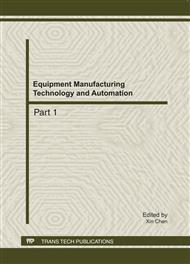[1]
Wei Shen, Wenxi Huang, Panrong Min. Cement process[M].Wuhan:Wuhan Industry Press, 1990.( In Chinese)
Google Scholar
[2]
Jiahui Peng. Investigation on hydration、hardening mechanism of modified alumina cement[J]. Journal of Chongqing Jianzhu University,1999,21(4):50–54. ( In Chinese)
Google Scholar
[3]
Jia-hui Peng, Xiaobo Gu. Study on the modified alumina cement[J].China Building Materials Science and Technology,1998,7(3):8~12. ( In Chinese)
Google Scholar
[4]
Yonghao Fang, Shuzhe Shi, Nanru Yang, et al. Primary study on high alumina cement phosphate CBC materials[J].Journal of Nanjing University of Chemical Technology ,1998,20(2):21-25. ( In Chinese)
Google Scholar
[5]
Yue Li, Shuguang Hu, Depo Yang, et al. Hydration activity reaction between the aluminate minerals and calcium carbonate[J]. Journal of Hebei Institute of Technology,1996,18(2):55-57. ( In Chinese)
Google Scholar
[6]
Shuguang Hu, Yue Li, Qingjun Ding. Studies to improve the long term strengthof alumina cement by limestone addition[J].Journal of Building Materials,1998,1(1):49-53. ( In Chinese)
Google Scholar
[7]
Shizong Long, Yanrong Wu, Quansheng Zhou. Study on the modified additive of the aluminate cement[J].Cement,1997,2(2):4-7. ( In Chinese)
Google Scholar
[8]
Darweesh H H M. Limestone as an accelerator and filler in lime-stone-substituted alumina cement[J]. Ceramics International,2004,30:145-150.
DOI: 10.1016/s0272-8842(03)00073-7
Google Scholar
[9]
Chan Y N,Luo X,Sun W. Compressive strength and pore structure of high-performance concrete after exposure to high temper-ature up to 800℃[J].Cement and Concrete Research,2000,30:247-251.
DOI: 10.1016/s0008-8846(99)00240-9
Google Scholar
[10]
Qian Tian. Mineral admixture of the self-compacting and high performance concrete[J].China Concrete and Cement Products,2000(5):18-20. ( In Chinese)
Google Scholar
[11]
Voglis N, Kakali G, Chaniotakis E, et al. Portland-limestone cements. Their properties and hydration compared to those of other composite cements[J].Cement and Concrete Composition,2005,27(2):191-196.
DOI: 10.1016/j.cemconcomp.2004.02.006
Google Scholar
[12]
John B. Further hydration investigations involving Portland cement and the substitution of limestone for gypsum[J]. World Cement ,1983 , 14(10) :383-392.
Google Scholar
[13]
Soroka I , Setter N. The effect of fillers on strength of cement mortars[J]. Cement and Concrete Research ,1977 ,7 (4) :449-456.
DOI: 10.1016/0008-8846(77)90073-4
Google Scholar
[14]
Shuguang Hu, Yue Li, Weijun Chen, et al. Impact of charge of limestone as additive upon properties of cement[J].Cement Engneering,1996 (2):22-24. ( In Chinese)
Google Scholar
[15]
Kuzel H J, Pollmann H. Hydration of C3A in the presence of Ca(OH)2,CaSO4•2H2O and CaCO3[J].Cement and Concrete Research,1991,21(5):885-895.
DOI: 10.1016/0008-8846(91)90183-i
Google Scholar
[16]
Jiachun Wang, Yutong Wang, Haiqing Gui, et al. Experimental study on effect of blending materials on high aluminum cement[J]. Journal of Shenyang Architectural and Civil Engineering Institute (Science and Technology), 2002, 18 (2):119-122. ( In Chinese)
Google Scholar
[17]
Soroka I, Stern N. The effect of fillers on strength of cement mortars[J]. Cement and Concrete Research, 1977, 7( 4) : 449- 456.
DOI: 10.1016/0008-8846(77)90073-4
Google Scholar
[18]
Xibi Chen, Zhaoqi Wu. Production and application of special cement[M]. Beijing: China Building Industry Press ,1994. ( In Chinese)
Google Scholar
[19]
GB/T1346-2001,Test methods for water requirement of normal consistency, setting time and soundness of the portland cements[S]. ( In Chinese)
Google Scholar
[20]
GB/T 2419-2005.Test method for fluidity of cement mortar[S]. ( In Chinese)
Google Scholar
[21]
Bonavetti VL, Donza HA, G. Menéndez, et al. Limestone filler cement in low w/c concrete a rational use of Energy[J]. Cement and Concrete Research ,2003,33(6):865-871.
DOI: 10.1016/s0008-8846(02)01087-6
Google Scholar
[22]
Cyr M,Lawrence P, Ringot E. Efficiency of mineral admixtures in mortars: quantification of the physical and chemical effects of fine admixtures in relation with compressive strength[J]. Cement and Concrete Research , 2006, 36(2): 264-77
DOI: 10.1016/j.cemconres.2005.07.001
Google Scholar


